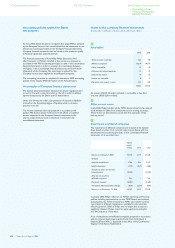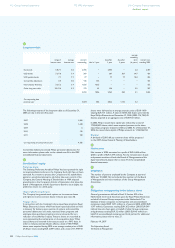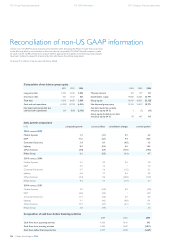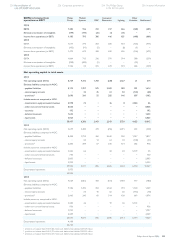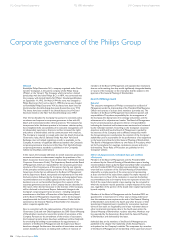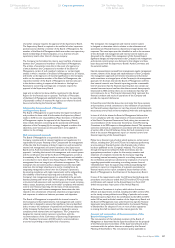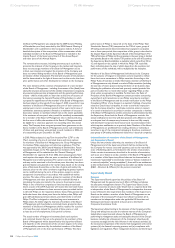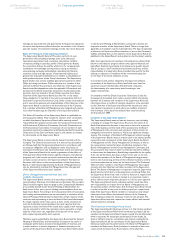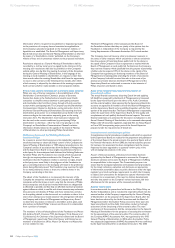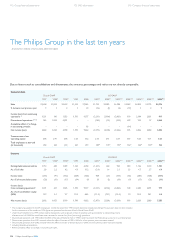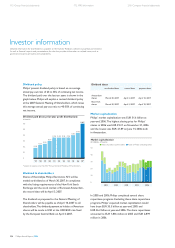Philips 2006 Annual Report Download - page 227
Download and view the complete annual report
Please find page 227 of the 2006 Philips annual report below. You can navigate through the pages in the report by either clicking on the pages listed below, or by using the keyword search tool below to find specific information within the annual report.
Philips Annual Report 2006 227
of another company requires the approval of the Supervisory Board.
The Supervisory Board is required to be notifi ed of other important
positions (to be) held by a member of the Board of Management. No
member of the Board of Management holds more than two supervisory
board memberships of listed companies, or is a chairman of such
supervisory board, other than of a Group company.
The Company has formalized its rules to avoid confl icts of interests
between the Company and members of the Board of Management.
The articles of association state that in the event of a legal act or
a lawsuit between the Company and a member of the Board of
Management, certain of such member’s relatives, or certain (legal)
entities in which a member of the Board of Management has an interest,
and insofar as the legal act is of material signifi cance to the Company
and/or to the respective member of the Board of Management, the
respective member of the Board of Management shall not take part
in the decision-making in respect of the lawsuit or the legal act.
Resolutions concerning such legal acts or lawsuits require the
approval of the Supervisory Board.
Legal acts as referred to above shall be mentioned in the Annual
Report for the fi nancial year in question. The Rules of Procedure
of the Board of Management establish further rules on the reporting
of (potential) confl icts of interests. No legal acts as referred to above
have occurred during the fi nancial year 2006.
Relationship between Board of Management
and Supervisory Board
The Board of Management is supervised by the Supervisory Board
and provides the latter with all information the Supervisory Board
needs to fulfi ll its own responsibilities. Major decisions of the Board
of Management require the approval of the Supervisory Board;
these include decisions concerning (a) the operational and fi nancial
objectives of the Company, (b) the strategy designed to achieve the
objectives, and, if necessary, (c) the parameters to be applied in
relation to the strategy.
Risk management approach
The Board of Management is responsible for ensuring that the
Company complies with all relevant legislation and regulations. It is
responsible for proper fi nancing of the Company and the management
of the risks that the Company is facing. It reports on and accounts for
internal risk management and control systems to the Supervisory
Board and its Audit Committee. Risk factors and the risk management
approach - including the internal risk management and control system
and the certifi cation thereof by the Board of Management, as well as
the sensitivity of the Company’s results to external factors and variables -
are described in more detail in the Annual Report. Within Philips, risk
management forms an integral part of business management. The
Company’s risk and control policy is designed to provide reasonable
assurance that strategic objectives are met by creating focus, by
integrating management control over the Company’s operations,
by ensuring compliance with legal requirements and by safeguarding
the reliability of the fi nancial reporting and its disclosures. The
Company’s risk management approach is embedded in the periodic
business planning and review cycle. With respect to fi nancial reporting
a structured self-assessment and monitoring process is used company-
wide to assess, document, review and monitor compliance with internal
control over fi nancial reporting. On the basis of risk assessments,
operating division and business management determines the risks
related to the achievement of business objectives and appropriate
risk responses in relation to business processes and objectives.
The Board of Management is responsible for internal control in
the Company and has implemented a risk management and control
system that is designed to ensure that signifi cant risks are identifi ed
and to monitor the realization of operational and fi nancial objectives
of the Company. Furthermore the system is designed to ensure
compliance with relevant laws and regulations. The Company has
designed its internal control system in accordance with the
recommendations of the Committee of Sponsoring Organizations
of the Treadway Commission (COSO), which recommendations
are aimed at providing a reasonable level of assurance.
The Company’s risk management and internal control system
is designed to determine risks in relation to the achievement of
operational and fi nancial business objectives and appropriate risk
responses. The most important risks identifi ed, as well as the structure
of the aforesaid risk management and internal control system, are
discussed in the chapter Risk management of this Annual Report.
Signifi cant changes and improvements in the Company’s risk management
and internal control system are disclosed in that chapter and have
been discussed with the Supervisory Board’s Audit Committee and
the external auditor.
Internal representations received from management, regular management
reviews, reviews of the design and implementation of the Company’s
risk management approach and reviews in business and functional
audit committees are integral parts of the Company’s risk management
approach. On the basis thereof, the Board of Management confi rms
that internal controls over fi nancial reporting provide a reasonable
level of assurance that the fi nancial reporting does not contain any
material inaccuracies, and confi rms that these controls have properly
functioned in 2006 and that there are no indications that they will
not continue to do so. The fi nancial statements fairly represent the
fi nancial condition and result of operations of the Company and
provide the required disclosures.
It should be noted that the above does not imply that these systems
and procedures provide certainty as to the realization of operational
and fi nancial business objectives, nor can they prevent all misstatements,
inaccuracies, errors, fraud and noncompliances with rules and regulations.
In view of all of the above the Board of Management believes that
it is in compliance with the requirements of recommendation II.1.4.
of the Dutch Corporate Governance Code, taking into account the
recommendation of the Corporate Governance Code Monitoring
Committee in its 2005-report on the application thereof. This statement
cannot be construed as a statement in accordance with the requirements
of section 404 of the US Sarbanes-Oxley Act. Such statement is set
forth in the section Management’s report on internal control over
fi nancial reporting of this Annual Report.
Philips has a fi nancial code of ethics which applies to certain senior
offi cers, including the CEO and CFO, and to employees performing
an accounting or fi nancial function (the fi nancial code of ethics
has been published on the Company’s website). The Company,
through the Supervisory Board’s Audit Committee, also has
appropriate procedures in place for the receipt, retention and
treatment of complaints received by the Company regarding
accounting, internal accounting controls or auditing matters and
the confi dential, anonymous submission by employees of concerns
regarding questionable accounting or auditing matters. Internal
‘whistleblowers’ have the opportunity, without jeopardizing their
position, to report on irregularities of a general, operational or
fi nancial nature and to report complaints about members of the
Board of Management to the Chairman of the Supervisory Board.
In view of the requirements under the US Securities Exchange Act,
procedures are in place to enable the CEO and the CFO to provide
certifi cations with respect to the Annual Report on Form 20-F
(which incorporates major parts of the Annual Report).
A Disclosure Committee is in place, which advises the various
offi cers and departments involved, including the CEO and the CFO,
on the timely review, publication and fi ling of periodic and current
(fi nancial) reports. Apart from the certifi cation by the CEO and CFO
under US law, each individual member of the Supervisory Board and
the Board of Management must under Dutch law, sign the fi nancial
statements being disclosed and submitted to the General Meeting
of Shareholders for adoption. If one or more of their signatures
is missing, this shall be stated, and the reasons given for this.
Amount and composition of the remuneration of the
Board of Management
The remuneration of the individual members of the Board of
Management is determined by the Supervisory Board on the proposal
of the Remuneration Committee of the Supervisory Board, and is
consistent with the policies thereon as adopted by the General
Meeting of Shareholders. The remuneration policy applicable to
226 Corporate governance224 Reconciliation of
non-US GAAP information
234 The Philips Group
in the last ten years
236 Investor information





